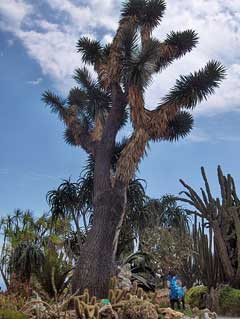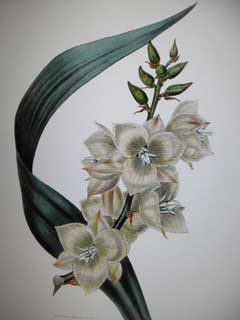 |
|
commons.wikimedia.org/wiki/User:JoJan |
 |
|
Translate this page:
Summary
Physical Characteristics

 Yucca filifera is an evergreen Shrub growing to 10 m (32ft 10in).
Yucca filifera is an evergreen Shrub growing to 10 m (32ft 10in).
See above for USDA hardiness. It is hardy to UK zone 7. It is in leaf all year, in flower from July to August. The species is hermaphrodite (has both male and female organs) and is pollinated by Hand.
Suitable for: light (sandy), medium (loamy) and heavy (clay) soils, prefers well-drained soil and can grow in nutritionally poor soil. Suitable pH: mildly acid, neutral and basic (mildly alkaline) soils. It can grow in semi-shade (light woodland) or no shade. It prefers dry or moist soil and can tolerate drought.
UK Hardiness Map
US Hardiness Map
Synonyms
Yucca baccata var. filifera. Yucca canaliculata var. filifera
Plant Habitats
Woodland Garden Sunny Edge;
Edible Uses
Edible Parts: Flowers Fruit Stem
Edible Uses:
Fruit - raw or cooked. Flowers - raw or cooked. Delicious raw, they can also be dried, crushed and used as a flavouring[164]. Flowering stem - cooked and used like asparagus[164].
References More on Edible Uses
Medicinal Uses
Plants For A Future can not take any responsibility for any adverse effects from the use of plants. Always seek advice from a professional before using a plant medicinally.
None known
References More on Medicinal Uses
The Bookshop: Edible Plant Books
Our Latest books on Perennial Plants For Food Forests and Permaculture Gardens in paperback or digital formats.

Edible Tropical Plants
Food Forest Plants for Hotter Conditions: 250+ Plants For Tropical Food Forests & Permaculture Gardens.
More

Edible Temperate Plants
Plants for Your Food Forest: 500 Plants for Temperate Food Forests & Permaculture Gardens.
More

More Books
PFAF have eight books available in paperback and digital formats. Browse the shop for more information.
Shop Now
Other Uses
Fibre Soap
A fibre obtained from the leaves is used for making ropes, baskets and mats[82, 169]. The roots are rich in saponins and can be used as a soap substitute[82].
Special Uses
References More on Other Uses
Cultivation details
Thrives in any soil but prefers a sandy loam and full exposure to the south[11]. Can succeed in light shade[K]. Plants are hardier when grown on poor sandy soils[200]. Established plants are very drought resistant[200]. Hardy to at least -5°c according to one report[200], whilst another says that it is hardy to about -30c[164]. The leaves can be damaged by strong winds[11]. In the plants native environment, its flowers can only be pollinated by a certain species of moth. This moth cannot live in Britain and, if fruit and seed is required, hand pollination is necessary. This can be quite easily and successfully done using something like a small paint brush. Individual crowns are monocarpic, dying after flowering[233]. However, the crown will usually produce a number of sideshoots before it dies and these will grow on to flower in about four years[233]. Plants in this genus are notably resistant to honey fungus[200]. Members of this genus seem to be immune to the predations of rabbits[233]
References Carbon Farming Information and Carbon Sequestration Information
Temperature Converter
Type a value in the Celsius field to convert the value to Fahrenheit:
Fahrenheit:
The PFAF Bookshop
Plants For A Future have a number of books available in paperback and digital form. Book titles include Edible Plants, Edible Perennials, Edible Trees,Edible Shrubs, Woodland Gardening, and Temperate Food Forest Plants. Our new book is Food Forest Plants For Hotter Conditions (Tropical and Sub-Tropical).
Shop Now
Plant Propagation
Seed - sow spring in a greenhouse. Pre-soaking the seed for 24 hours in warm water may reduce the germination time. It usually germinates within 1 - 12 months if kept at a temperature of 20°c. Prick out the seedlings into individual pots when they are large enough to handle and grow them on in the greenhouse or cold frame for at least their first two winters. Plant them out into their permanent positions in early summer and consider giving them some winter protection for at least their first winter outdoors - a simple pane of glass is usually sufficient[K]. Seed is not produced in Britain unless the flowers are hand pollinated. Root cuttings in late winter or early spring. Lift in April/May and remove small buds from base of stem and rhizomes. Dip in dry wood ashes to stop any bleeding and plant in a sandy soil in pots in a greenhouse until established[78]. Division of suckers in late spring. Larger divisions can be planted out direct into their permanent positions. We have found that it is best to pot up smaller divisions and grow them on in light shade in a greenhouse or cold frame until they are growing away well. Plant them out in the following spring.
Other Names
If available other names are mentioned here
Native Range
NORTHERN AMERICA: Mexico (Coahuila de Zaragoza, Nuevo León, San Luis Potosí, Tamaulipas, Zacatecas, Guanajuato, Hidalgo, México, Michoacán de Ocampo, Querétaro)
Weed Potential
Right plant wrong place. We are currently updating this section.
Please note that a plant may be invasive in one area but may not in your area so it's worth checking.
Conservation Status
IUCN Red List of Threatened Plants Status :

| Related Plants
|
| Latin Name | Common Name | Habit | Height | Hardiness | Growth | Soil | Shade | Moisture | Edible | Medicinal | Other |
| Hesperaloe funifera | New Mexico false yucca | Perennial | 1.8 |
6-9
| S | LM | N | DM | 0 | 0 | 2 |
| Yucca aloifolia | Spanish Bayonet, Aloe yucca, Dagger Plant, Yucca, Spanish Bayonet | Tree | 7.5 |
8-10
| S | LMH | SN | DM | 3 | 1 | 2 |
| Yucca angustissima | Narrowleaf yucca, Kanab yucca, Toft's yucca, Yucca | Shrub | 0.4 |
4-9
| S | LMH | SN | DM | 3 | 0 | 4 |
| Yucca baccata | Spanish Bayonet, Banana yucca, Blue Yucca, Spanish Yucca | Shrub | 0.9 |
6-11
| S | LMH | N | DM | 4 | 1 | 5 |
| Yucca brevifolia | Joshua Tree, Jaeger's Joshua tree, Yucca, Joshua Tree | Tree | 9.0 |
9-11
| M | LMH | SN | DM | 3 | 0 | 2 |
| Yucca constricta | Buckley's Yucca | Perennial | 1.5 |
8-11
| | LMH | SN | DM | 2 | 0 | 2 |
| Yucca elata | Soap Tree, Soaptree yucca, Soapweed, Soapweed Yucca | Shrub | 2.0 |
9-11
| S | LMH | SN | DM | 2 | 0 | 3 |
| Yucca filamentosa | Spoonleaf Yucca, Adam's needle, Desert Candle, Needle Palm, St. Peter's Palm, Spanish Bayonet, Comm | Shrub | 1.2 |
4-10
| M | LMH | SN | DM | 3 | 1 | 4 |
| Yucca gigantea | Spineless yucca, Izote | Tree | 6.0 |
9-11
| F | LMH | SN | DM | 3 | 0 | 2 |
| Yucca glauca | Soapweed, Soapweed yucca, Gurney's yucca, American Vetch, Yucca, Narrowleaf Yucca, Soapweed | Shrub | 1.5 |
4-10
| S | LMH | SN | DM | 2 | 2 | 2 |
| Yucca gloriosa | Spanish Dagger, moundlily yucca, Palm Lily, Roman Candle, Mound Lily Yucca, Spanish Dagger | Shrub | 1.8 |
6-11
| S | LM | SN | DM | 2 | 1 | 2 |
| Yucca harrimaniae | Spanish Bayonet, New Mexico Spanish bayonet | Shrub | 0.4 |
6-9
| S | LMH | SN | DM | 2 | 0 | 2 |
| Yucca recurvifolia | Curve-leaf yucca | Shrub | 2.5 |
7-10
| | LMH | SN | DM | 3 | 0 | 2 |
| Yucca rupicola | Twisted-Leaf Yucca, Texas yucca | Shrub | 0.6 |
8-11
| | LMH | SN | DM | 2 | 0 | 2 |
| Yucca schidigera | Mojave Yucca, Yucca | Tree | 4.5 |
9-10
| | LMH | N | DM | 3 | 0 | 2 |
| Yucca smalliana | Adam's Needle, Weak-leaf yucca | Shrub | 1.2 |
8-11
| | LMH | SN | DM | 2 | 0 | 2 |
| Yucca treculiana | Torrey’s yucca or Spanish dagger | Tree | 10.0 |
7-11
| S | LMH | N | DM | 3 | 2 | 3 |
| Yucca whipplei | Our Lord's Candle | Shrub | 2.0 |
7-11
| S | LMH | S | DM | 3 | 0 | 3 |
|
Growth: S = slow M = medium F = fast. Soil: L = light (sandy) M = medium H = heavy (clay). pH: A = acid N = neutral B = basic (alkaline). Shade: F = full shade S = semi-shade N = no shade. Moisture: D = dry M = Moist We = wet Wa = water.
Now available:
Food Forest Plants for Mediterranean Conditions
350+ Perennial Plants For Mediterranean and Drier Food Forests and Permaculture Gardens.
[Paperback and eBook]
This is the third in Plants For A Future's series of plant guides for food forests tailored to
specific climate zones. Following volumes on temperate and tropical ecosystems, this book focuses
on species suited to Mediterranean conditions—regions with hot, dry summers and cool, wet winters,
often facing the added challenge of climate change.
Read More
Expert comment
Author
Chadaub.
Botanical References
1172200
Links / References
For a list of references used on this page please go here
Readers comment
© 2010, Plants For A Future. Plants For A Future is a charitable company limited by guarantee, registered in England and Wales. Charity No. 1057719, Company No. 3204567.